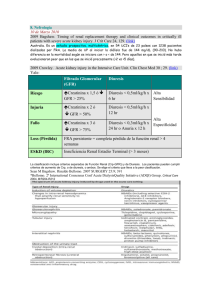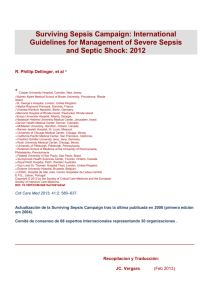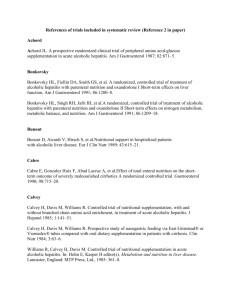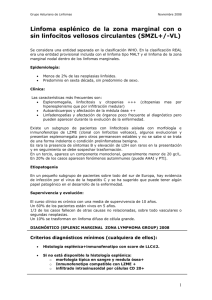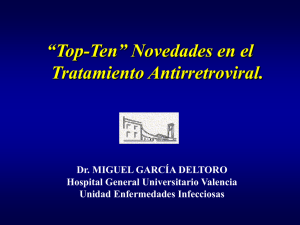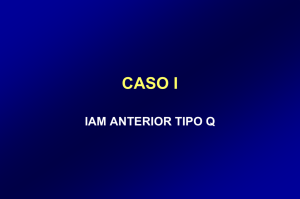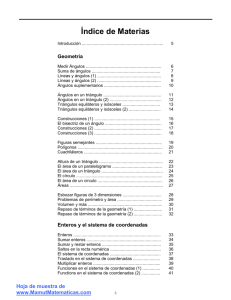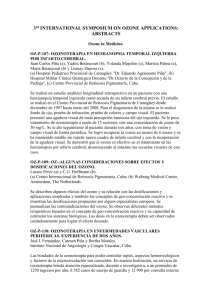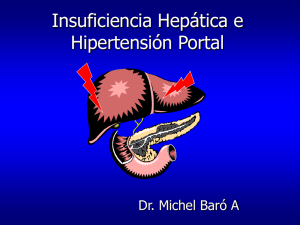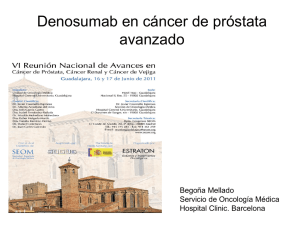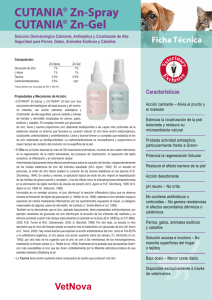Votrient® (pazopanib) Core communications
advertisement
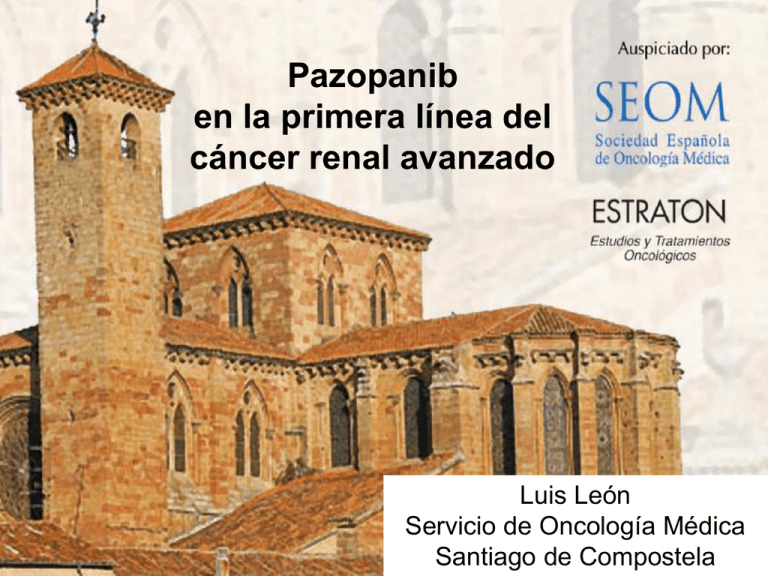
Pazopanib en la primera línea del cáncer renal avanzado Pazopanib en el tratamiento del Carcinoma de Células Renales Luis León Servicio de Oncología Médica Santiago de Compostela 1 Pazopanib bloquea moléculas clave implicadas en la angiogénesis PDGFR VEGFR-1 VEGFR-2 VEGFR-3 c-KIT Tumour cell membrane P P P P RAS P P P P P P P P PI3K Proliferation P P P P FAK Survival 1. Sonpavde et al. Expert Opin Investig Drugs 2008;17:253–61. P P P P PLC Migration 2 Inhibidor multikinasa Kinases inhibited with IC50 <1 μM Pazopanib Sunitinib Sorafenib 32 54 25 1. Kumar et al. Br J Cancer 2009;101:1717–23. Figure adapted from Karaman et al. Nat Biotechnol 2008;26:127–32. 3 Datos de Eficacia 4 Phase II study: VEG1026161 Inclusion • ECOG performance status 0 or 1 • Treatment-naïve or one prior cytokine or bevacizumab failure Patients with advanced or metastatic RCC (N=225) Pazopanib 800 mg once daily for 12 weeks Complete/partial response Progressive disease Stable disease Randomization Pazopanib 800 mg once daily (n=170) Pazopanib 800 mg once daily (n=27) Clinicaltrials.gov identifier NCT002447642 Matching placebo (n=28) Patients received pazopanib after interim analysis 1. Hutson et al. J Clin Oncol 2010;28:475–80. 2. US NIH. Available from: http://clinicaltrials.gov/ct2/show/NCT00244764?term=pazopanib+renal&rank=2 (last updated Jan 6, 2011) 5 Objetivos del estudio (revisados)1 Objetivo principal % de respuestas según RECIST (PFS antes de la modificación) Objetivos secundarios Duración de respuesta PFS durante la fase de aleatorización Seguridad y tolerabilidad Análisis global PFS 1. Hutson et al. J Clin Oncol 2010;28:475–80. 6 Características de los pacientes Characteristic Mean age, years (range) Patients (N=225) 59.8 (32–81) Gender, n (%) Female Male 69 (31) 156 (69) Prior nephrectomy, n (%) 205 (91) Prior radiotherapy, n (%) 43 (19) Prior systemic therapy, n (%) No prior systemic therapy Prior systemic therapy* 155 (69) 70 (31) MSKCC risk criteria, n (%)† Favourable Intermediate Poor Unknown 97 (43) 92 (41) 5 (2) 31 (14)‡ *Cytokine, chemotherapy, hormonal or bevacizumab-based regimens; †For 162 patients, calcium instead of corrected-calcium was used to derive their total MSKCC risk factor; ‡31 patients were missing data on ≥1 of the 5 risk factors and, thus, did not have sufficient data to be assigned to a risk category 1. Hutson et al. J Clin Oncol 2010;28:475–80. 7 8 Tasa de respuesta global1 Overall response rate (%) 50 40 Pazopanib 800 mg once daily 35 34 Overall population Cytokine-naïve 37 30 20 10 0 1. Hutson et al. J Clin Oncol 2010;28:475–80. Bevacizumab or cytokine pretreated 9 Pazopanib es superior a placebo en PFS1 Proportion progression-free 1.0 0.8 Median: 51.7 weeks2 (95% CI: 43.9, 60.3) Week 12 randomization point 0.6 6.2 months (4.6, 10.9) Log-rank, p=0.01282 11.9 months (10.0, –) 0.4 0.2 Pazopanib Placebo 0.0 0 10 20 30 40 50 60 Weeks on study 70 80 90 100 La comparación de PFS por un comité independiente demostró una ventaja a favor de pazopanib Los pacientes cruzados a pazopanib no se censuraron 1. Hutson et al. J Clin Oncol 2010;28:475–80. 10 Phase III study: VEG1051921 Patients with advanced/ metastatic RCC (N=435) Stratification • ECOG performance status 0 versus 1 • Prior nephrectomy • Treatment-naïve (n=233) versus one cytokine failure (n=202) Randomization 2:1 Pazopanib 800 mg once daily (n=290) Matching placebo (n=145) Option to receive pazopanib via an open-label study at progression Clinicaltrials.gov identifier NCT00334282 VEG107769 open-label study 71 patients enrolled* 1. Sternberg et al. J Clin Oncol 2010;28:1061-1068 11 Objetivos del estudio1 Objetivo principal PFS Objetivos secundarios OS ORR Duración de respuesta Seguridad y tolerabilidad Análisis global PFS Otros: calidad de vida 1. Sternberg et al. J Clin Oncol 2010;28:1061-1068 12 Característica basales1 Characteristic Pazopanib (n=290) Placebo (n=145) Median age, year (range) 59 (28–85) 60 (25–81) Gender, % male 68 75 Most common metastatic sites, % Lung Lymph node Bone Liver 74 54 28 26 73 59 26 22 Number of organs involved, % 1 and 2 ≥3 45 55 48 52 ECOG performance status, % 0 1 42 58 41 59 MSKCC risk category, % Favourable Intermediate Poor Unknown* 39 55 3 3 39 53 3 4 *Missing results for one or more of the five risk criteria 1. Sternberg et al. J Clin Oncol 2010;28:1061-1068 13 Porcentaje de respuestas Pazopanib Placebo Overall response rate (%) p<0.001 35 32 30 29 30 25 20 15 10 5 3 4 3 0 Overall population (n=435) 1. Sternberg et al. J Clin Oncol 2010;28:1061-1068 Treatment-naïve Cytokine (n=155) pretreated (n=78) 14 Supervivencia libre de progresión en toda la población1 Proportion progression-free 1.0 Median PFS (months) Placebo Pazopanib Hazard ratio (95% CI) p value (1-sided) 0.8 4.2 9.2 0.46 (0.34, 0.62) <0.0001 0.6 0.4 0.2 Pazopanib Placebo 0.0 Number at risk, n Pazopanib Placebo 0 5 10 Time (month) 15 20 290 145 159 38 76 14 29 2 6 In the overall study population, PFS was significantly greater in pazopanib- versus placebo-treated patients (p<0.0001) 1. Sternberg et al. J Clin Oncol 2010;28:1061-1068 15 Supervivencia libre de progresión en los pacientes no pretratados1,2 Proportion progression-free 1.0 Median PFS (months) Placebo Pazopanib Hazard ratio (95% CI) p value (1-sided) 0.8 2.8 11.1 0.40 (0.27, 0.60) <0.0001 0.6 0.4 0.2 Pazopanib Placebo 0.0 Number at risk, n Pazopanib Placebo 0 5 10 Time (month) 15 20 155 78 84 22 39 7 11 2 1 In the treatment-naïve subpopulation, PFS was significantly greater in pazopanib- versus placebotreated patients (p<0.0001) 1. Sternberg et al. J Clin Oncol 2010;28:1061-1068 16 Supervivencia libre de progresión en los pacientes tratados con citoquinas1,2 Proportion progression-free 1.0 Median PFS (months) Placebo Pazopanib Hazard ratio (95% CI) p value (1-sided) 0.8 4.2 7.4 0.54 (0.35, 0.84) <0.001 0.6 0.4 0.2 Pazopanib Placebo 0.0 Number at risk, n Pazopanib Placebo 0 5 10 Time (month) 15 20 135 67 75 16 37 7 18 5 In the cytokine-pretreated subpopulation, PFS was significantly greater in pazopanib- versus placebo-treated patients (p<0.001) 1. Sternberg et al. J Clin Oncol 2010;28:1061-1068 17 Beneficio en todos los subgrupos Hazard ratio (95% CI) Baseline factor Primary analysis MSKCC risk: favourable MSKCC risk: intermediate Female Male Age <65 years Age ≥65 years ECOG performance status 0 ECOG performance status 1 0.2 p<0.001 by log-rank test for all 0.4 0.6 0.8 1.0 1.2 Favours pazopanib Favours placebo PFS was significantly improved with pazopanib across all sub-groups: Age, gender, PS and MSKCC risk status 1. Sternberg et al. J Clin Oncol 2010;28:1061-1068 18 Objetivo principal: OS 1.0 Hazard ratio=0.91 95% CI (0.71–1.16) p=0.224 Proportion surviving 0.8 Median OS Pazopanib: 22.9 months Placebo: 20.5 months 0.6 0.4 Pazopanib Placebo 0.2 54% of placebo patients crossed over Time of crossover 0.0 0 10 20 30 40 290 145 213 93 147 71 95 53 25 9 Patients at risk Pazopanib Placebo Sternberg et al. Annals Oncol 2010; 21(Suppl 8): Abstract LBA22 and oral presentation Time (months) Toxicidad 20 Efectos de clase en ensayo fase III (VEG105192)1 Pazopanib (n=290) Placebo (n=145) All grades, % All grades, % 9 0 7 (3)2 0 Hand–foot syndrome 6 <1 Mucositis/stomatitis 4/4 <1/0 Arterial thromboembolic 3* 0 Adverse event Proteinuria Hypothyroidism *2% of arterial thromboembolic events were Grade 3 or worse in severity 1. Sternberg et al. J Clin Oncol 2010;28:1061-1068; 2. Wolter ASCO 2011 21 22 Efectos adversos de Pazopanib en ensayos fase II y III *presentes en ≥10% of pacientes VEG1026161 Adverse event VEG1051922 Pazopanib (n=225), % Pazopanib (n=290), % Placebo (n=145), % All grade Grade 3 Grade 4 All grade Grade 3 Grade 4 All grade* Grade 3 Grade 4 Diarrhoea 63 4 0 52 3 <1 9 <1 0 Hypertension 41 9 0 40 4 0 10 <1 0 Hair colour changes 43 0 0 38 <1 0 3 0 0 Nausea 42 <1 0 26 <1 0 9 0 0 Anorexia 24 <1 0 22 2 0 10 <1 0 Vomiting 20 <1 0 21 2 <1 8 2 0 Fatigue 46 5 0 19 2 0 8 1 1 Asthenia – – – 14 3 0 8 0 0 Abdominal pain 16 3 0 11 2 0 1 0 0 Headache 20 0 0 10 0 0 5 0 0 *In study VEG105192, 4 and 3% of patients in the pazopanib and placebo arms, respectively, had Grade 5 adverse events 1. Hutson et al. J Clin Oncol 2010;28:475–80. et al. J Clin Oncol 2010;28:1061-1068 2. Sternberg . 23 Pazopanib: elevación de transaminasas y Br Proportion of subjects, % Pazopanib (n=290) Placebo (n=145) All grades Grade 3 Grade 4 All grades Grade 3 Grade 4 ALT increase 53 10 2 22 1 0 AST increase 53 7 <1 19 <1 0 Br increase 36 3 <1 10 1 <1 Alkaline phosphatase 27 1 <1 35 2 0 • Liver enzyme elevations were largely reversible following dose modification, interruption or cessation1 • Many subjects were able to continue on pazopanib and adapted • Fatal hepatic events were reviewed across the entire safety database (N=1830) Out of 1830 subjects there were two fatal cases, which were possibly attributable to pazopanib. This is equivalent to 0.1% (95% CI: 0.03, 0.4)1 1. US FDA. Available from: http://www.fda.gov/downloads/AdvisoryCommittees/CommitteesMeetingMaterials/Drugs/OncologicDrugsAdvisoryCommittee/UCM186338.pdf 2. Kapadia, ASCO 2011. 24 La elevación de ALT asociada a Pazopanib se produce de forma temprana1 Cumulative incidence 0.16 0.14 0.12 0.10 0.08 0.06 0.04 ALT >5X ULN (N=586) 0.02 0.0 0 6 12 24 32 48 64 80 96 112 Weeks Elevations in ALT levels were detected in the first 18 weeks of pazopanib treatment in the vast majority of subjects who developed such abnormalities 1. US FDA. Available from: http://www.fda.gov/downloads/AdvisoryCommittees/CommitteesMeetingMaterials/Drugs/OncologicDrugsAdvisoryCommittee/UCM 186338.pdf 25 Modificación o retraso de dosis debidos a efectos secundarios VEG1026161 VEG1051922,3 Pazopanib (n=225) Pazopanib (n=290) Placebo (n=145) Dose reduction due to adverse events, % 31* 243 33 Treatment discontinuation due to adverse events, % 15 14† 3† Treatment modification *Subsequent re-escalations in approximately 50% of patients who reduced their dose of pazopanib; †Not including three patients who, in addition to adverse events, had concurrent other reasons at the time they discontinued participation in the study 1. Hutson et al. J Clin Oncol 2010;28:475–80. 2. Sternberg et al. J Clin Oncol 2010;28:1061-1068 3. GlaxoSmithKline. Data on file. 26 Comparison of 20% QoL Deterioration Rates for Pazopanib-Treated and Placebo Patients, EORTC QLQ-C30 Treatment-Naive Patients Pazopanib Placebo 0 56 112 168 224 280 336 392 448 Event Rates (%) Event Rates (%) All Patients 100 90 80 70 60 50 40 30 20 10 0 504 100 90 80 70 60 50 40 30 20 10 0 Pazopanib Placebo 0 56 112 168 Event Rates (%) Cytokine-Pretreated Patients 100 90 80 70 60 50 40 30 20 10 0 Pazopanib Placebo 0 56 224 280 336 392 Number of Days Until Event Number of Days Until Event 112 168 224 280 336 Number of Days Until Event ASCO Annual Meeting; June 3-7, 2011; Chicago, IL. 392 448 504 EORTC QLQ-C30 Global Health Status/QOL Scale 1.0 0.9 0.8 0.7 0.6 0.5 0.4 0.3 0.2 0.1 0 Pazopanib Placebo 0 10 20 30 40 50 60 70 80 90 100 Cumulative Distribution Function Cumulative Distribution Function HRQoL Deterioration Cumulative Distribution Function HRQoL Deterioration From Baseline EQ-5D Utility Index 1.0 0.9 0.8 0.7 0.6 0.5 0.4 0.3 0.2 0.1 0 Pazopanib Placebo 0 10 20 30 40 50 60 70 80 90 100 HRQoL Deterioration From Baseline EQ-5D VAS Score 1.0 0.9 0.8 0.7 0.6 0.5 0.4 0.3 0.2 0.1 0 Pazopanib Placebo 0 10 20 30 40 50 60 70 80 90 100 HRQoL Deterioration From Baseline ASCO Annual Meeting; June 3-7, 2011; Chicago, IL. (A) IL8 2767AT (rs1126647) (B) IL8 251TA (rs4073) (A)HIF1A IL8 2767AT (C) (rs1126647); (B) 1790GA IL8 251TA (rs11549467) (rs4073); (C) HIF1A 1790GA (rs11549467). 29 CONCLUSIONES - Pazopanib es superior a placebo (PFS) en primera línea de cáncer renal metastásico - Pazopanib obtiene un porcentaje de respuestas del 30% en esta población - La tolerancia a pazopanib es buena, y las toxicidades manejables - Debe prestarse especial atención a las alteraciones en la función hepática - Pazopanib no produce un deterioro en la calidad de vida - Necesitamos marcadores predictivos de respuesta 30 ¿Cuál es el camino? 31 Gracias 32
